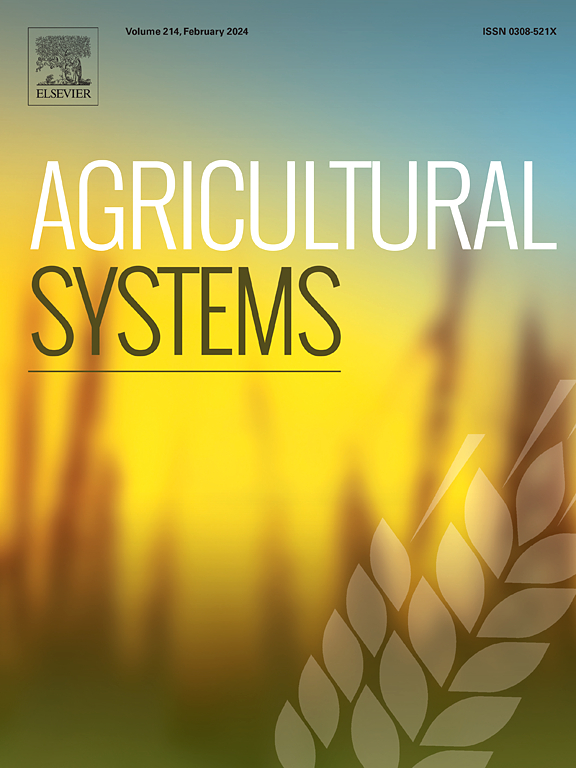Traditional rice-fish system benefits sustainable production of small farms and conservation of local resources
IF 6.1
1区 农林科学
Q1 AGRICULTURE, MULTIDISCIPLINARY
引用次数: 0
Abstract
CONTEXT
Small farms account for most of the world's farms (approximately 84 % of the world's farms are <2 ha in size). Helping smallholder farms achieve sustainable production is one the Sustainable Development Goals (SDGs). Worldwide, traditional agriculture has contributed to food and livelihood security of smallholder farms for centuries. The values of traditional agriculture in supporting sustainable production and in conserving local resources, however, has often been overlooked in science and policy making.
OBJECTIVE
Our objective is to examine whether and how traditional agriculture benefits sustainable production of smallholder farms and concomitantly conserving local resources.
METHODS
We performed the study in sites of the Globally/China-Nationally Important Agricultural Heritage System (i.e., rice-fish system, RF), which has been practiced by smallholders in southwestern China. Six counties that have a long history of rice-fish farming were included. We used a stratified sampling protocol with three strata (county, town, and village) in the field and farmer surveys, and in the sample collections. Sixteen towns and twenty-eight villages were sampled. ArcGIS (10.3.1) was used to estimate the sizes of the paddy field and farms. Data of yields were collected from farmer harvest. Field surveys were conducted to measure the depth of water layer in paddy fields and to collect samples of rice and fish. Shannon- Wiener's diversity index (H) was used to indicate rice variety diversity. Microsatellite DNA was used to evaluate genetic diversity of rice and fish (common carp, Cypinus carpio).
RESULTS AND CONCLUSION
Compared to rice monoculture (RM) smallholders, RF smallholders produced more stable rice yield but used fewer synthetic pesticides and fertilizers. RF smallholders obtained a certain quantity of fish yield from paddy fields, and had higher net income than RM smallholders. RF system in our study sites stored a large amount of rainwater during rainy season, and harbored diverse local rice varieties and indigenous common carp populations. Six morphotypes of indigenous common carp based on body coloration patterns and nomenclature assigned by local farmers were found in RF system. Shannon- Wiener's diversity index (H) of rice variety in RF system was higher than in RM system. Microsatellite DNA test further indicated that both local rice varieties and indigenous common carp exhibited high level of genetic diversity.
SIGNIFICANCE
Our results highlight the importance of traditional agricultural systems (e.g., rice-fish system) in enhancing sustainable production of smallholder farms and conservation of local resources. Recognizing the value of these traditional agricultural systems would help to boost support policies.

传统的稻鱼系统有利于小农场的可持续生产和当地资源的保护
小农场占世界农场的大多数(世界上约84%的农场面积为2公顷)。帮助小农实现可持续生产是可持续发展目标之一。在世界范围内,几个世纪以来,传统农业为小农的粮食和生计安全做出了贡献。然而,传统农业在支持可持续生产和保护当地资源方面的价值在科学和政策制定中经常被忽视。我们的目标是研究传统农业是否以及如何有利于小农农场的可持续生产,并同时保护当地资源。方法在中国西南地区小农已实践的全球/中国-国家重要农业文化遗产系统遗址(即稻鱼系统,RF)进行研究。其中包括6个拥有悠久稻鱼养殖历史的县。在田间和农民调查以及样本收集中,我们采用了三层(县、镇和村)分层抽样方案。16个城镇和28个村庄被抽样调查。利用ArcGIS(10.3.1)软件估算水田和农田面积。产量数据是从农民收获中收集的。实地调查了稻田水层深度,采集了水稻和鱼类样本。采用Shannon- Wiener多样性指数(H)表示水稻品种多样性。利用微卫星DNA对水稻和鱼类(鲤鱼)的遗传多样性进行了评价。结果与结论与单作小农相比,单作小农的水稻产量更稳定,但使用的合成农药和化肥较少。RF小农从水田中获得了一定的鱼产量,净收入高于RM小农。研究地点的射频系统在雨季储存了大量的雨水,并为多种当地水稻品种和本地鲤鱼种群提供了避难所。在RF系统中发现了6种基于身体颜色模式和当地农民指定的命名法的本地鲤鱼形态。RF系统下水稻品种Shannon- Wiener多样性指数(H)高于RM系统。微卫星DNA测试进一步表明,地方水稻品种和地方鲤鱼都表现出较高的遗传多样性。我们的研究结果强调了传统农业系统(如稻鱼系统)在提高小农可持续生产和保护当地资源方面的重要性。认识到这些传统农业系统的价值将有助于推动支持政策。
本文章由计算机程序翻译,如有差异,请以英文原文为准。
求助全文
约1分钟内获得全文
求助全文
来源期刊

Agricultural Systems
农林科学-农业综合
CiteScore
13.30
自引率
7.60%
发文量
174
审稿时长
30 days
期刊介绍:
Agricultural Systems is an international journal that deals with interactions - among the components of agricultural systems, among hierarchical levels of agricultural systems, between agricultural and other land use systems, and between agricultural systems and their natural, social and economic environments.
The scope includes the development and application of systems analysis methodologies in the following areas:
Systems approaches in the sustainable intensification of agriculture; pathways for sustainable intensification; crop-livestock integration; farm-level resource allocation; quantification of benefits and trade-offs at farm to landscape levels; integrative, participatory and dynamic modelling approaches for qualitative and quantitative assessments of agricultural systems and decision making;
The interactions between agricultural and non-agricultural landscapes; the multiple services of agricultural systems; food security and the environment;
Global change and adaptation science; transformational adaptations as driven by changes in climate, policy, values and attitudes influencing the design of farming systems;
Development and application of farming systems design tools and methods for impact, scenario and case study analysis; managing the complexities of dynamic agricultural systems; innovation systems and multi stakeholder arrangements that support or promote change and (or) inform policy decisions.
 求助内容:
求助内容: 应助结果提醒方式:
应助结果提醒方式:


